How to identify a fake text message
Scam texts could fool you into revealing personal information or installing malware, putting you at risk of identity theft. Read on to learn how to identify a fake text message, and add an extra layer of security to your digital life with Norton 360, featuring AI-powered scam detection.
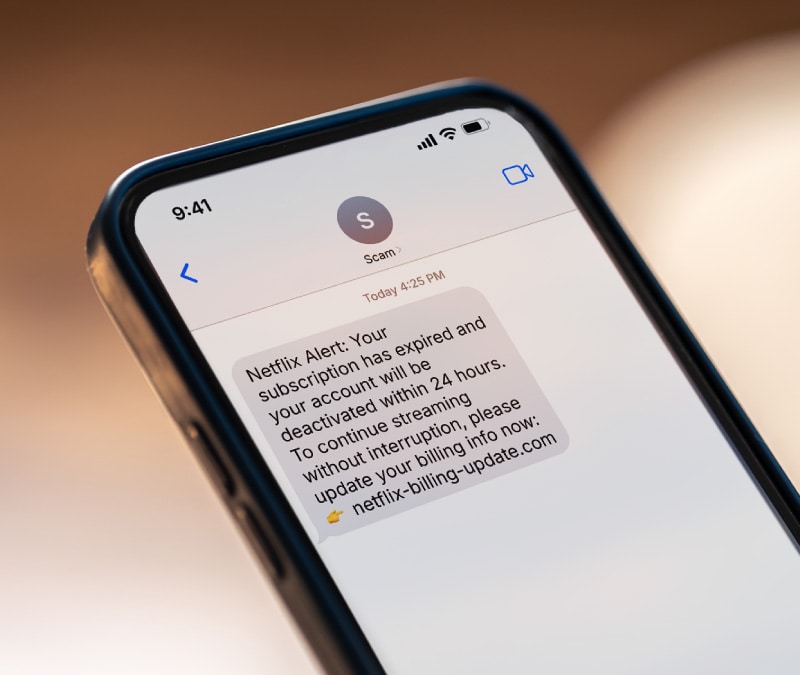
Scammers behind fake texts often impersonate legitimate businesses, automated systems, and even people you know to fool you into revealing sensitive information or sending money. In 2024 alone, victims reported around $470 million in losses from text scams, a fivefold jump since 2020. Read on to learn how to spot a fake text, explore real-world examples, and find out what to do if you’re targeted.
Be alert: scammers read the news
During national crises, cybercriminals tailor their messages to exploit confusion and fear. The 2025 government shutdown is a prime example.
Government agencies are warning the public about government shutdown scams. Cybercriminals are sending fake texts claiming people’s Medicare has been cancelled, or that furloughed government workers can still get paid — if they click a malicious link. These messages are scams.
Government shutdown scam texts and emails often have alarming subject lines like “Government Shutdown Notice” or “Benefit Suspension.” Clicking links in these messages could lead to identity theft or stolen funds.
1. Check the sender’s information
If you receive an odd text from a friend or company that feels out of character, double-check the number the text is coming from. Tap the profile picture in your messaging app to review the sender’s details — just keep in mind that scammers can spoof real phone numbers, so a message might still be fake even if it looks like it came from someone you know.
Look for these red flags under the sender details:
- Spoofed caller ID: Using spoofing techniques, scammers can disguise their caller ID information to make it look like the message is coming from a trusted source, but the real number may still be visible in the message details.
- Unrecognized numbers: Texts from unfamiliar numbers are more likely to be fake. If a message claims to be from a company’s customer service, it’s best to verify it through the company’s official website.
- Foreign country codes: Texts from different countries are more likely to be scams, especially if the sender claims to be a U.S.-based service. One Reddit user received a fake USPS text from a non-U.S. number containing a fake “package delivery update.”
You can use built-in features in messaging apps, like Google Messages and Apple iMessage, to check basic sender info and flag potential spam. For more advanced protection, AI tools included in Norton 360 Deluxe can help keep you safe from today's most sophisticated text scams.
Are texts from five-digit numbers legit?
Many legitimate companies use short codes (typically five or six digits) for automated texts like delivery updates or account alerts. For example, USPS often uses short codes when sending tracking notifications.
2. Analyze the message content
Fake text messages use fear or threats to pressure you into taking action before thinking. You may also spot grammatical errors not typically found in messages from companies, or notice that your “friend” isn’t writing in their normal style or tone.
Here’s what to look for in the message:
- Emotional stakes: Scammers rely on emotional manipulation to make you act before thinking. One Reddit user was offered a portion of someone’s Powerball winnings in a text group — but only if they clicked a phishing link.
- Limited time frame: Scammers urge you to take immediate action, or else you’ll face potential consequences or miss out on a once-in-a-lifetime opportunity. For example, IRS tax scams may urge you to act now to claim a refund.
- “Wrong number” text: Cybercriminals sometimes send texts that seem to be intended for others, hoping you respond with “wrong number,” which signals that your number is active. Databases of active numbers may then be sold on the dark web to other scammers and spammers.
- Grammar errors: Look for misspelled words or unusual grammar that an official organization wouldn’t typically use. If possible, compare the text with other messages from the sender to confirm your suspicions.
- Generic greetings: Messages containing “dear customer,” “hi there,” or “user” may signal that the sender doesn’t know who you are. These generic greetings could indicate a cybercriminal is trying to collect your information in a smishing attack.
- Unusual tone: Scammers may use an overly formal tone when communicating. Terms like “dear” or “kindly yours” can be a red flag, because friends or companies don’t often use these words, even in formal situations.
To make their messages sound more natural, scammers now use advanced AI chatbots, which make fake texts harder to detect. Fortunately, AI can also work in your favor.
Norton 360 Deluxe includes AI-powered scam detection, which draws on a vast database of known scams to recognize patterns that might fool the human eye. It helps identify suspicious texts and websites, while also protecting your device with award-winning antivirus software.
3. Inspect links and attachments
Fake texts can include links to unsafe websites or Trojan-laden attachments that install malicious software on your device. You can review URLs by using link previews at the bottom of each text or by holding your thumb on the link until the URL appears.
Here’s what to look for in suspicious links and attachments:
- Shortened URLs: Criminals use URL shorteners to hide redirections to malicious websites. If you receive an unsolicited text with a link containing “tinyurl” or “bit.ly,” preview it before opening. These links could send you to unsafe sites.
- Lookalike URLs: To hide fake websites and steal your information, scammers use URLs that look similar to those of legit companies. For example, “norton.com” resembles “noorton.com” closely, but the first is legitimate while the second is an example of typosquatting.
- QR codes: QR codes can hide malicious links or files. An unsolicited text containing a QR code could be a quishing attack.
- Suspicious attachments: Attachments from unknown numbers may contain malware. Companies rarely send text attachments and will often direct you to their website instead.
4. Evaluate their request
Fake texts often contain unusual requests, such as a streaming service asking for your Social Security number, or a relative asking you to urgently send money because they’re “stuck in India.”
Here are some requests that could indicate a fake text:
- Provide sensitive information: Trustworthy organizations usually don’t ask for sensitive information over text. For example, a company requesting your Social Security number over text is most likely a scammer.
- Apply for this job: Unsolicited job offers sent over text are often fake. For example, a recent college graduate replied to one of these fake offers, which proposed a $35 hourly wage for a work-from-home position, only to learn it was a scam later.
- Send gift cards: Scammers often ask for gift cards, as they’re difficult to trace. However, such requests are often totally incongruous: a “friend” claiming to have car trouble who’s asking for help in the form of gift cards is definitely a scammer.
- Confirm your account: Cybercriminals often pretend to be automated account systems and send out links to fake login pages. Entering your account credentials on these websites could compromise your account.
5. Use AI-powered scam detection
AI-powered scam detectors give you extra confidence when identifying fake texts. Combined with your own judgment, AI-powered scam detectors can help you determine when to ignore a message and block the sender.
Norton 360 Deluxe is a cybersecurity package that draws on a rich database of fake texts to spot patterns humans may have difficulty detecting, helping alert you if you’re at risk. It can also warn you about unsafe websites and help protect you from data-stealing malware with its award-winning antivirus.
Fake text message examples
Some examples of fake texts you may encounter include prizes, delivery alerts, IRS scams, and toll notifications.
Fake prize or reward texts
Fake prize texts aim to fool you into thinking you’ve won a fabulous prize. One 87-year-old Florida man thought he won hundreds of thousands from a text, but lost over $10,000 instead.


USPS delivery alerts
Fake USPS delivery alerts often claim you need to confirm your personal information to receive a package. In 2024, these texts represented about 17% of all text fraud reported to the Federal Trade Commission (FTC).
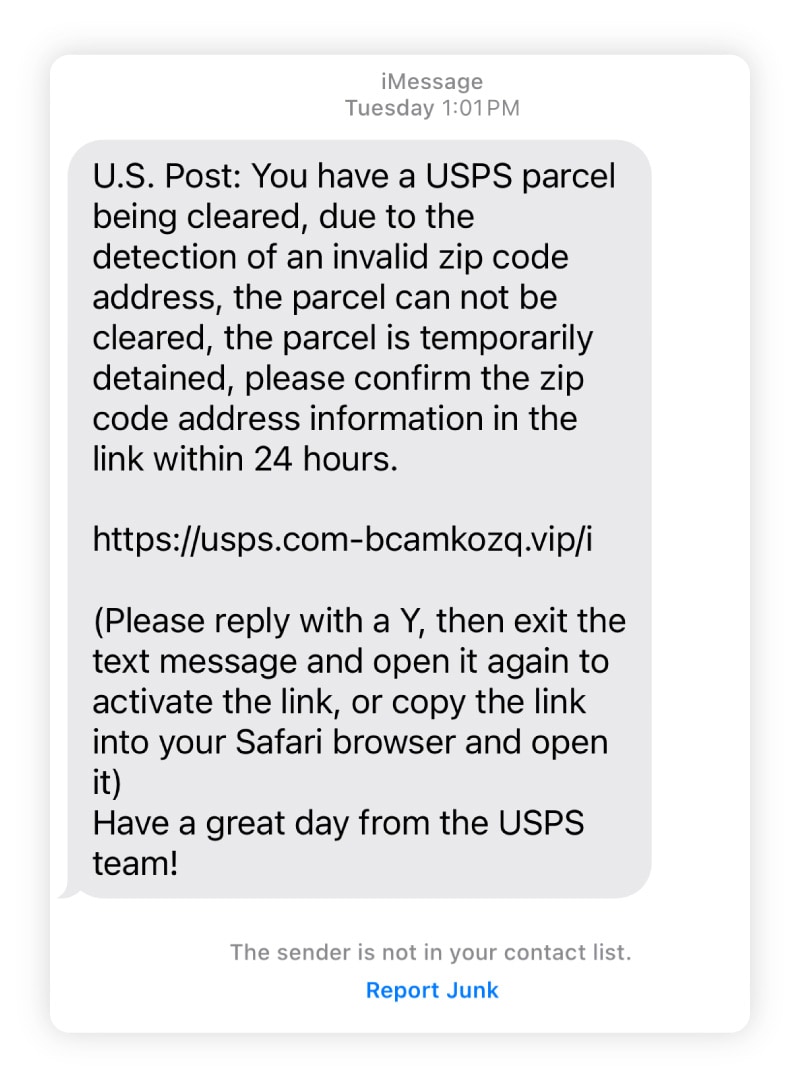

Toll notifications
Fake toll messages fool targets into thinking they owe an outstanding balance for using toll roads. The Internet Crime Complaint Center (IC3) received over 2,000 such complaints from March to April of 2024. Fraudsters include links to spoofed sites resembling official toll collection pages.
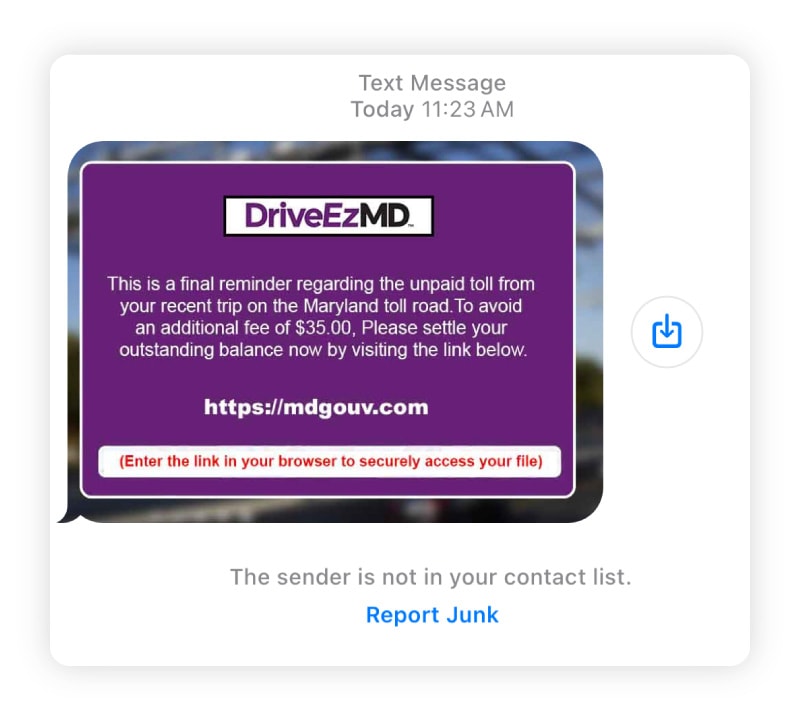

Expired subscription notifications
Expired subscription texts fool targets into thinking they owe a past-due subscription. Streaming services usually notify you of failed payments via email, not text.
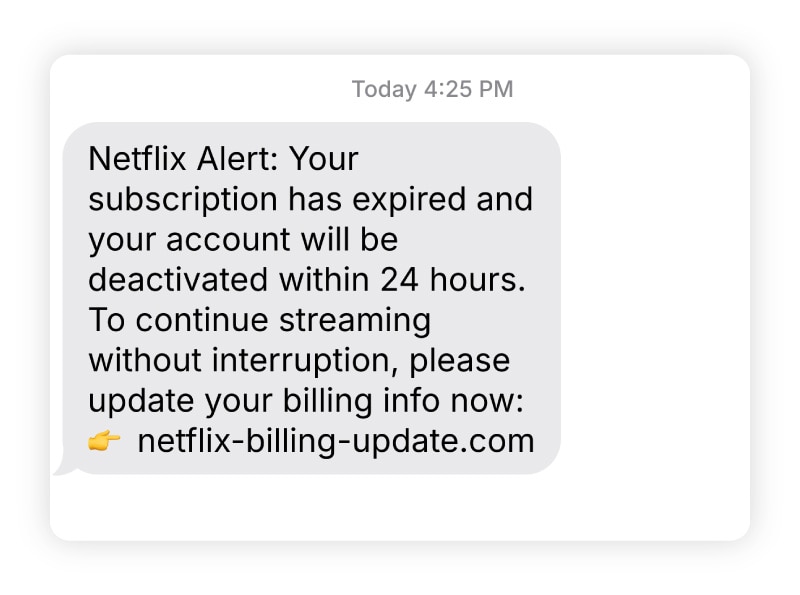

IRS tax notifications
Fake IRS scam texts are when criminals try to scare you into thinking you owe taxes or fees. According to its website, the IRS never contacts taxpayers via text.
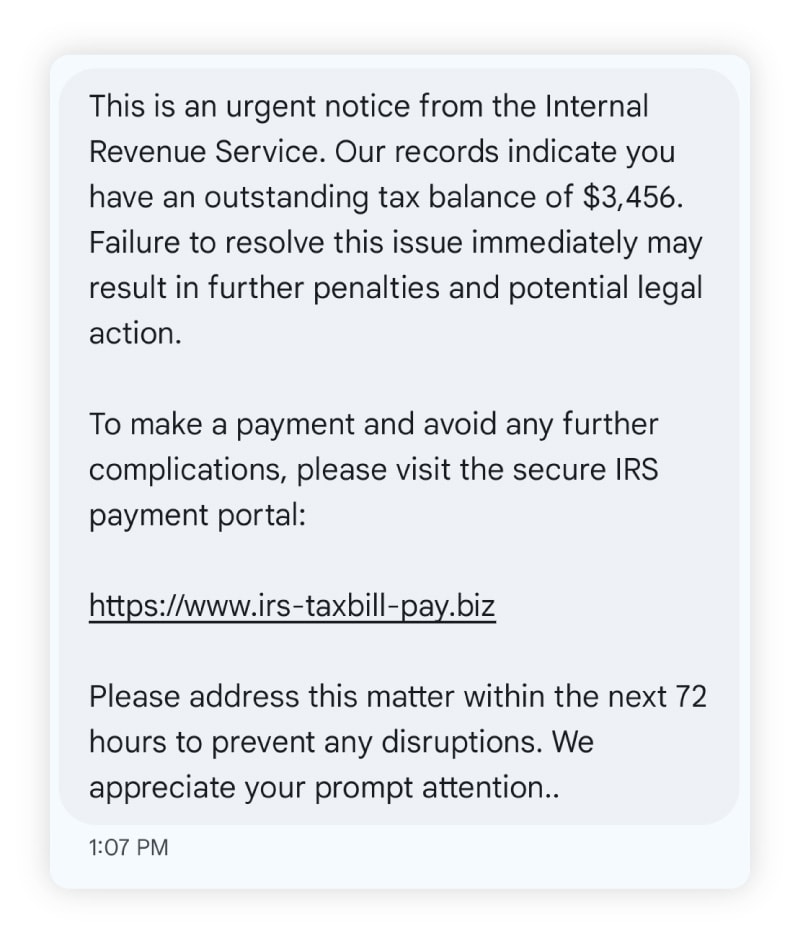

Job offers
Fake job texts often offer easy, lucrative work to entice you to respond. One news investigator was offered $10,000 per month for 60 minutes of work a day. They even underwent fake interviews on Telegram.
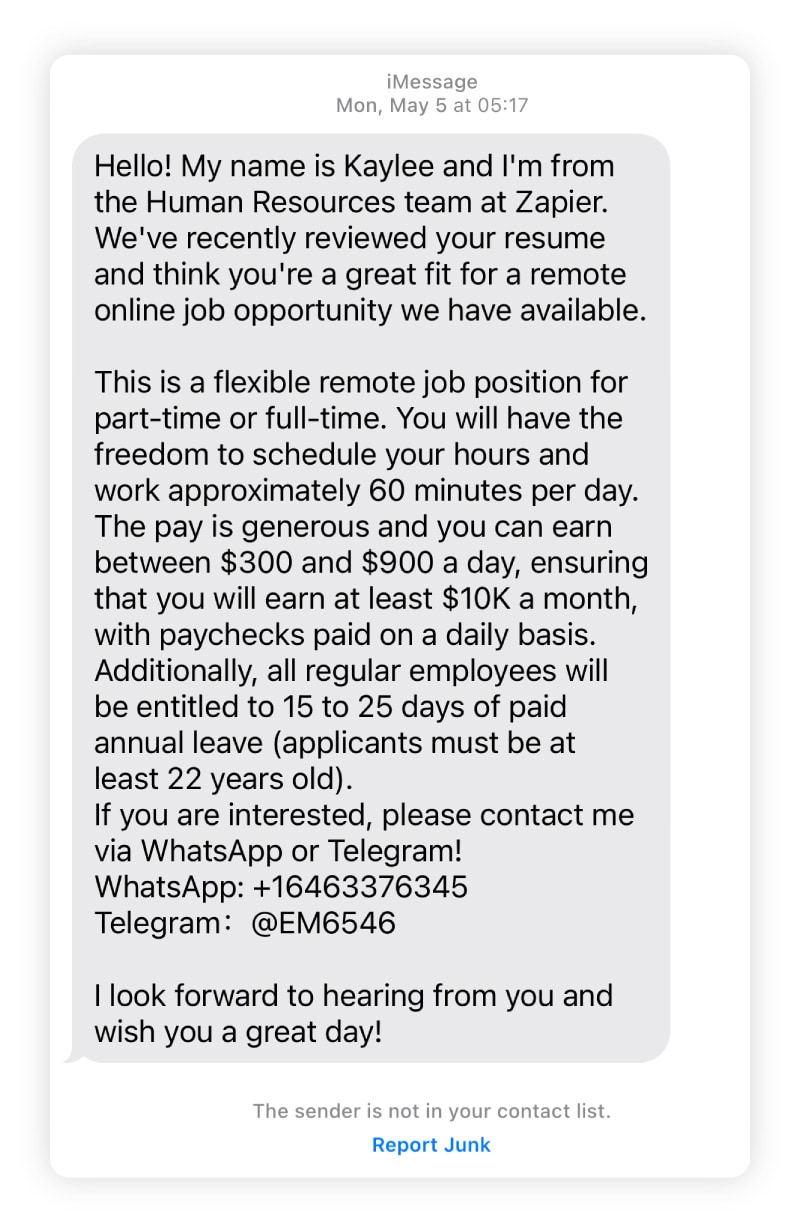

Boss texts
Fake boss texts pretend to be your manager, CEO, or some other corporate authority figure to fool you into providing money or information. In one BBB scam tracker alert, a target lost over $1,000 when a scammer impersonated their manager and convinced them to buy gift cards as a surprise for everyone in the office. The scammer then requested photos of the receipts and both sides of the gift cards, allowing them to make off with the money.
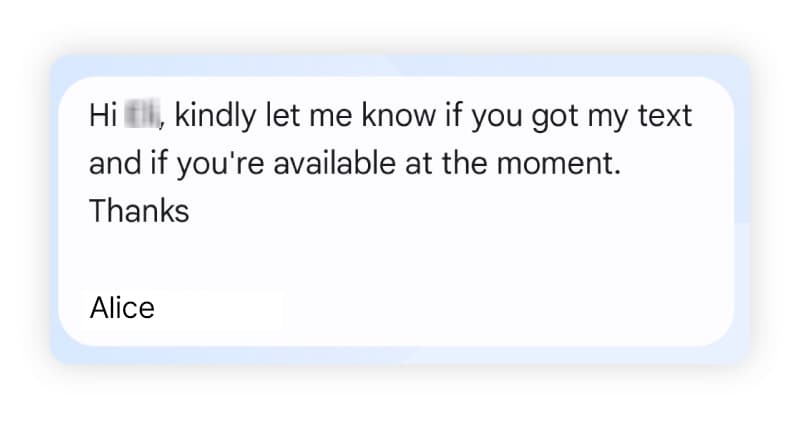

Friend or family member needs help
Fake texts supposedly from family or friends, sometimes called “hi mom texts,” often contain requests for money to help with an emergency. In one case, a scammer used AI voice cloning to pretend to have kidnapped a woman’s daughter, explained that she needed to pay $1,000,000 for her return. Scammers can also send these deepfake AI voice clips over text.
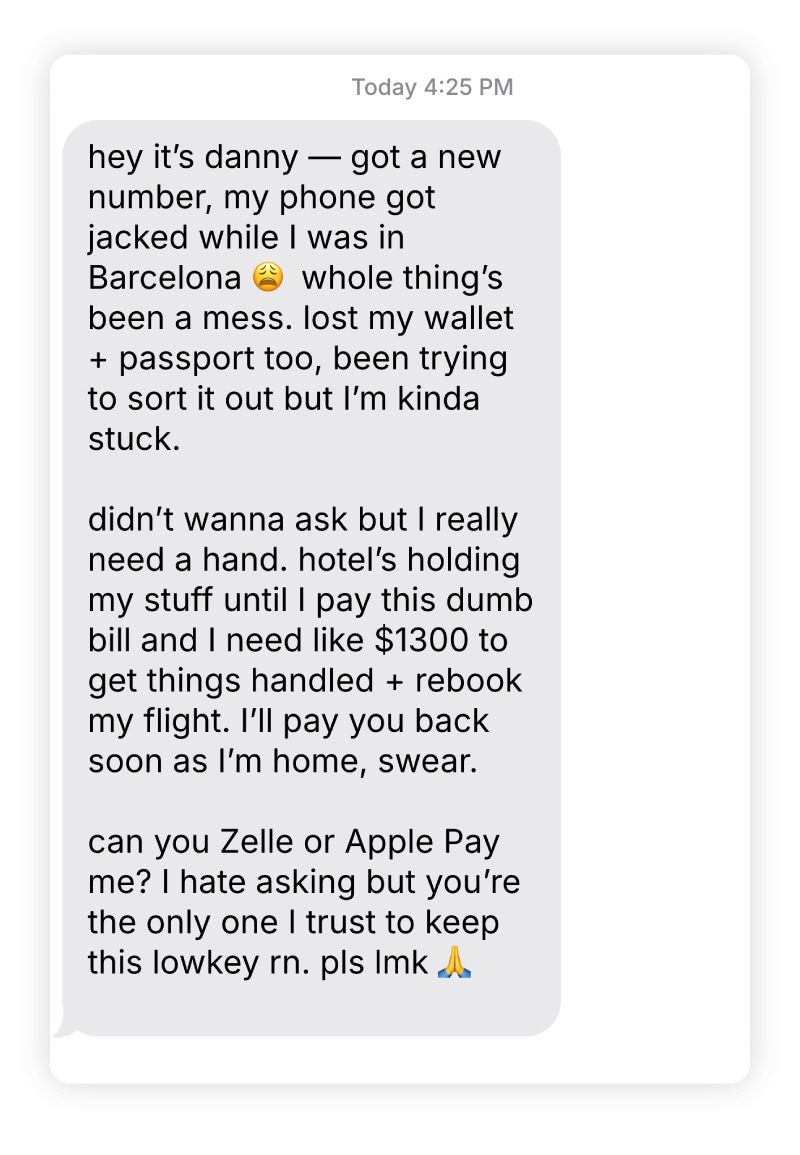

Cryptocurrency investment texts
Fake cryptocurrency scam texts offer recipients enormous profits from crypto investments, often directing them to fake websites. One Ohio woman lost $8.2 million when scammers pretended to be her friend to fool her into giving up her life savings for crypto investments.


Bank alerts
Fake bank texts pretend to be your bank, often asking you to confirm a transaction or click a link. In one case, scammers targeted Merrimack County Savings Bank customers, asking them to click a fake link to verify a purchase.
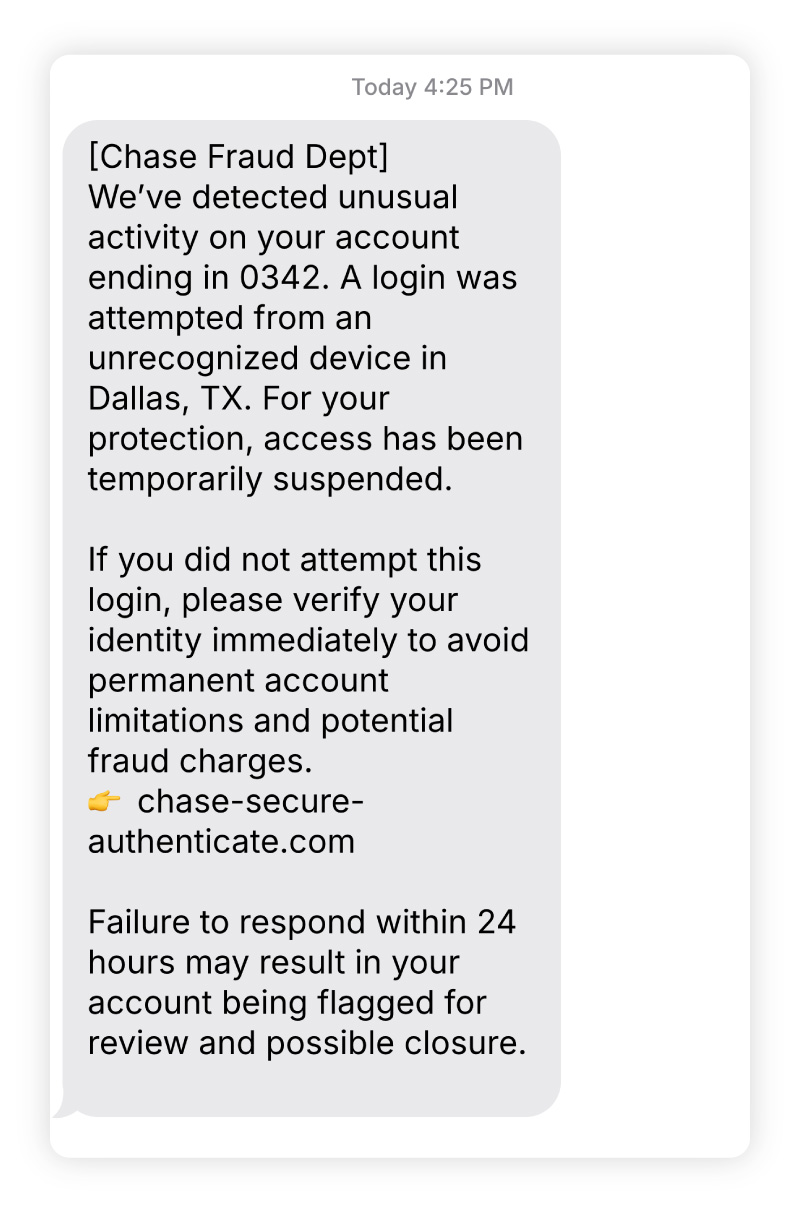

Wrong number texts
Fake “wrong-number” texts are often short, friendly messages where the scammers pretend the text is for someone else. When doing this, scammers generate your number randomly, sending a text to confirm your number is active and ready to be a future scam target.


How to handle fake text messages
If you receive a fake text message, ignore it, block the sender, and report it to your phone carrier. You can also verify if the text is real by double-checking the company’s website or talking directly with the supposed text sender on a different platform.
Here’s how you can handle these fake texts:
- Don’t respond: Even if you’re tempted, do not reply with “STOP” or interact with the message in any way. Responding will likely result in more messages, making it more difficult to stop spam texts.
- Report them: You can report the message by forwarding it to 7726 (SPAM). You can also report messages on iOS with a long press or on Android via the three-dot menu in the upper-right corner of the text.
- Block them: You can often block the texter by holding your finger down on the text and choosing the option to block. This helps you stop the same number from spamming you with unwanted messages.
- Verify independently: If you’re unsure whether the message is fake, check the sender by contacting them through alternative channels. If it comes from a business, double-check the phone number by searching for it on the company’s official page.
- Verify the URL: Long-pressing a URL allows you to preview it before you open it. URLs that do not lead to the company’s website should be avoided.
- Filter messages: Enabling filters for unknown senders can help screen out potential scam texts. It’s a useful way to block messages from unfamiliar numbers, but keep in mind that it might not work if the caller uses spoofed caller ID information.
What should I do if I accidentally interact with a fake text?
If you accidentally interact with a fake text by clicking a link or replying, immediately switch your device to airplane mode. Disconnecting from the internet can help limit data transmission and potentially prevent further activity from malicious sites you may have landed on.
Here’s what you should do if you interacted with a fake text:
- Don’t reply: If you’ve already responded, stop engaging with the sender. Ignoring and blocking the number can help discourage the scammer from targeting you again.
- Scan for malware: Run a malware scan if you clicked a link or opened an attachment. If you already have an antivirus installed, real-time protection may stop downloaded malware from compromising your device.
- Report the incident to the FTC: Report the scam to the Federal Trade Commission (FTC), including any fake websites you visited. The more information you have, the more the FTC can act on it.
- Change your login credentials: If you accidentally enter your login credentials on a fake website, change your passwords. Setting up multi-factor authentication and using a password manager to ensure your passwords are unique can help protect your accounts.
- Tell your bank: If you accidentally entered payment information on a fake website, notify your bank. They may issue you a new card or account number, and in some instances, they may cancel fraudulent transactions.
Stay safe from dangerous fake texts
Advancements in AI are making it easier for cybercriminals to fool victims with fake texts and other forms of phishing. Norton 360 Deluxe can help you see through scammers’ tricks and lies with Norton Genie, a powerful AI assistant trained on an enormous database of scams and malicious websites.
Plus, with award-winning malware protection for your devices, a VPN, deepfake protection, and a host of other essential features, you’ll be able to enjoy a safer, freer, and more private online experience.
FAQs
Is it safe to reply STOP to text messages
No, it is not safe to reply STOP to text messages, because it confirms to scammers that your number is active. Replying to fake texts is likely to increase the amount of spam and scams you get — so it’s best not to engage at all.
What if a spam text comes from a contact I know?
If you receive a spam text from a contact, a hacker might have their number. Ignore the text, and reach out to your contact via a different channel to ask about the message.
Can I block spam texts permanently?
You can permanently block spam texts from a specific number by long-pressing the text (on iPhones) or using the three-dot menu (on Androids).
Can my phone get hacked from a text message?
Yes, your phone can get hacked from a text message if you click a link that’s infected with malware.
Editorial note: Our articles provide educational information for you. Our offerings may not cover or protect against every type of crime, fraud, or threat we write about. Our goal is to increase awareness about Cyber Safety. Please review complete Terms during enrollment or setup. Remember that no one can prevent all identity theft or cybercrime, and that LifeLock does not monitor all transactions at all businesses. The Norton and LifeLock brands are part of Gen Digital Inc.









Want more?
Follow us for all the latest news, tips, and updates.